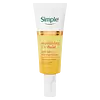What's inside
What's inside
 Key Ingredients
Key Ingredients

 Benefits
Benefits

 Concerns
Concerns

 Ingredients Side-by-side
Ingredients Side-by-side

Water
Skin ConditioningOctocrylene
UV AbsorberCaprylyl Methicone
Skin ConditioningEthylhexyl Salicylate
UV AbsorberDicaprylyl Carbonate
EmollientButyl Methoxydibenzoylmethane
UV AbsorberGlycerin
HumectantPhenylbenzimidazole Sulfonic Acid
UV AbsorberEthylhexyl Methoxycinnamate
UV AbsorberTriethanolamine
BufferingSilica
AbrasiveNiacinamide
SmoothingPhenoxyethanol
PreservativeXanthan Gum
EmulsifyingCaprylyl Glycol
EmollientCetyl Alcohol
EmollientGlyceryl Stearate
EmollientLysine Carboxymethyl Cysteinate
Skin ConditioningPEG-75 Stearate
Gluconolactone
Skin ConditioningDisodium EDTA
Steareth-20
CleansingCeteth-20
CleansingGlutathione
BHT
AntioxidantTocopherol
AntioxidantWater, Octocrylene, Caprylyl Methicone, Ethylhexyl Salicylate, Dicaprylyl Carbonate, Butyl Methoxydibenzoylmethane, Glycerin, Phenylbenzimidazole Sulfonic Acid, Ethylhexyl Methoxycinnamate, Triethanolamine, Silica, Niacinamide, Phenoxyethanol, Xanthan Gum, Caprylyl Glycol, Cetyl Alcohol, Glyceryl Stearate, Lysine Carboxymethyl Cysteinate, PEG-75 Stearate, Gluconolactone, Disodium EDTA, Steareth-20, Ceteth-20, Glutathione, BHT, Tocopherol
Oryza Sativa Bran Water
MaskingDibutyl Adipate
EmollientCaprylyl Methicone
Skin ConditioningDiethylamino Hydroxybenzoyl Hexyl Benzoate
UV FilterEthylhexyl Triazone
UV AbsorberSargassum Fluitans / Natans Extract
Butyloctyl Salicylate
Skin ConditioningBis-Ethylhexyloxyphenol Methoxyphenyl Triazine
Skin ConditioningDimethicone
EmollientMicrocrystalline Cellulose
AbsorbentNiacinamide
SmoothingSilica
AbrasiveCeramide NP
Skin ConditioningCeramide As
Skin ConditioningCeramide EOP
Skin ConditioningCeramide Ns
Skin ConditioningCeramide Ng
Skin ConditioningMethylene Bis-Benzotriazolyl Tetramethylbutylphenol
UV FilterHydroxyethyl Acrylate/Sodium Acryloyldimethyl Taurate Copolymer
Emulsion StabilisingAmmonium Acryloyldimethyltaurate/Beheneth-25 Methacrylate Crosspolymer
Emulsion StabilisingCucumis Sativus Fruit Extract
EmollientSodium Polyacrylate
AbsorbentVp/Acrylates/Lauryl Methacrylate Copolymer
Xanthan Gum
EmulsifyingDecyl Glucoside
CleansingTocopheryl Acetate
AntioxidantPentylene Glycol
Skin ConditioningPropylene Glycol
HumectantPropanediol
Solvent1,2-Hexanediol
Skin ConditioningHexyldecanol
EmollientHydroxypropyl Cyclodextrin
MaskingPhenoxyethanol
PreservativeSodium Gluconate
Skin ConditioningOryza Sativa Bran Water, Dibutyl Adipate, Caprylyl Methicone, Diethylamino Hydroxybenzoyl Hexyl Benzoate, Ethylhexyl Triazone, Sargassum Fluitans / Natans Extract, Butyloctyl Salicylate, Bis-Ethylhexyloxyphenol Methoxyphenyl Triazine, Dimethicone, Microcrystalline Cellulose, Niacinamide, Silica, Ceramide NP, Ceramide As, Ceramide EOP, Ceramide Ns, Ceramide Ng, Methylene Bis-Benzotriazolyl Tetramethylbutylphenol, Hydroxyethyl Acrylate/Sodium Acryloyldimethyl Taurate Copolymer, Ammonium Acryloyldimethyltaurate/Beheneth-25 Methacrylate Crosspolymer, Cucumis Sativus Fruit Extract, Sodium Polyacrylate, Vp/Acrylates/Lauryl Methacrylate Copolymer, Xanthan Gum, Decyl Glucoside, Tocopheryl Acetate, Pentylene Glycol, Propylene Glycol, Propanediol, 1,2-Hexanediol, Hexyldecanol, Hydroxypropyl Cyclodextrin, Phenoxyethanol, Sodium Gluconate
Ingredients Explained
These ingredients are found in both products.
Ingredients higher up in an ingredient list are typically present in a larger amount.
Caprylyl Methicone is a type of silicone.
It helps soften and soothe the skin by creating a thin film on top. This film helps trap moisture, keeping your skin hydrated.
Niacinamide is a multitasking form of vitamin B3 that strengthens the skin barrier, reduces pores and dark spots, regulates oil, and improves signs of aging.
And the best part? It's gentle and well-tolerated by most skin types, including sensitive and reactive skin.
You might have heard of "niacin flush", or the reddening of skin that causes itchiness. Niacinamide has not been found to cause this.
In very rare cases, some individuals may not be able to tolerate niacinamide at all or experience an allergic reaction to it.
If you are experiencing flaking, irritation, and dryness with this ingredient, be sure to double check all your products as this ingredient can be found in all categories of skincare.
When incorporating niacinamide into your routine, look out for concentration amounts. Typically, 5% niacinamide provides benefits such as fading dark spots. However, if you have sensitive skin, it is better to begin with a smaller concentration.
When you apply niacinamide to your skin, your body converts it into nicotinamide adenine dinucleotide (NAD). NAD is an essential coenzyme that is already found in your cells as "fuel" and powers countless biological processes.
In your skin, NAD helps repair cell damage, produce new healthy cells, support collagen production, strengthen the skin barrier, and fight environmental stressors (like UV and pollution).
Our natural NAD levels start to decline with age, leading to slower skin repair, visible aging, and a weaker skin barrier. By providing your skin niacinamide, you're recharging your skin's NAD levels. This leads to stronger, healthier, and younger looking skin.
Another name for vitamin B3 is nicotinamide. This vitamin is water-soluble and our bodies don't store it. We obtain Vitamin B3 from either food or skincare. Meat, fish, wheat, yeast, and leafy greens contain vitamin B3.
The type of niacinamide used in skincare is synthetically created.
Learn more about NiacinamidePhenoxyethanol is a preservative that has germicide, antimicrobial, and aromatic properties. Studies show that phenoxyethanol can prevent microbial growth. By itself, it has a scent that is similar to that of a rose.
It's often used in formulations along with Caprylyl Glycol to preserve the shelf life of products.
Silica, also known as silicon dioxide, is a naturally occurring mineral. It is used as a fine, spherical, and porous powder in cosmetics.
Though it has exfoliant properties, the function of silica varies depending on the product.
The unique structure of silica enhances the spreadability and adds smoothness, making it a great texture enhancer.
It is also used as an active carrier, emulsifier, and mattifier due to its ability to absorb excess oil.
In some products, tiny microneedles called spicules are made from silica or hydrolyzed sponge. When you rub them in, they lightly polish away dead skin layers and enhance the penetration of active ingredients.
Learn more about SilicaXanthan gum is used as a stabilizer and thickener within cosmetic products. It helps give products a sticky, thick feeling - preventing them from being too runny.
On the technical side of things, xanthan gum is a polysaccharide - a combination consisting of multiple sugar molecules bonded together.
Xanthan gum is a pretty common and great ingredient. It is a natural, non-toxic, non-irritating ingredient that is also commonly used in food products.
Learn more about Xanthan Gum